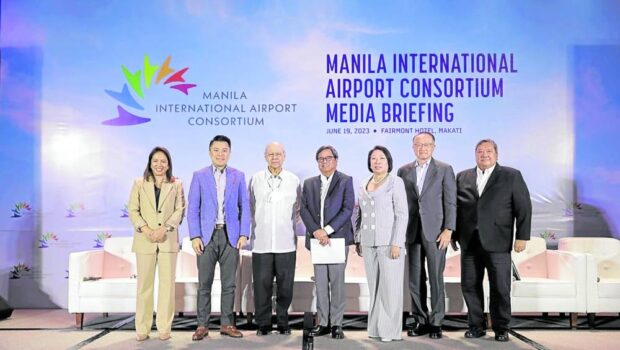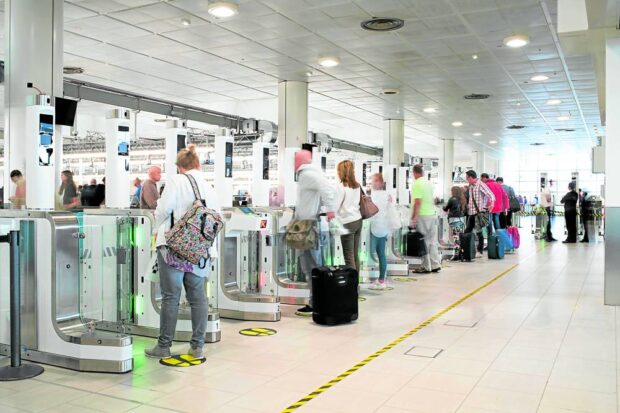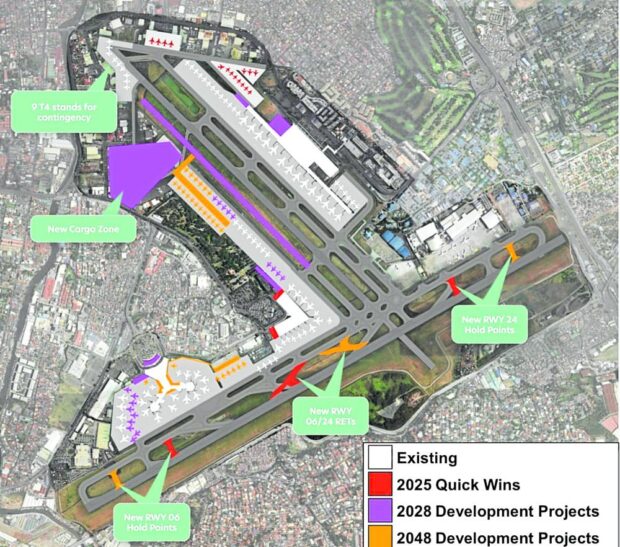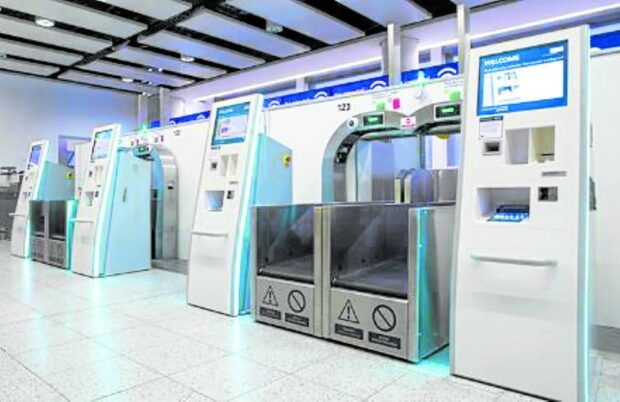This is what Naia could be

SUPER CONSORTIUM From left: Aboitiz InfraCapital president and CEO Cosette Canilao, AGI CEO Kevin Tan, LTG chief financial officer Jose Gabriel Olives, Ayala Corp. president and CEO Cezar Consing, FDC president and CEO Josephine Gotianun-Yap, GIP vice chairman Jim Yong Kim and JG Summit senior advisor Bach Johann Sebastian —Contributed photos
Airports are filled with heart-warming stories, especially those of returning overseas workers who are excited to see their family after years of being apart. Tight hugs, kind words and genuine smiles are all around. However, airports can also make or break a traveler’s first impression of the country.
The Manila International Airport Consortium (MIAC) is on the quest of turning Ninoy Aquino International Airport (Naia) around so it can give a good impression on travelers.
“The foundational importance of air transport and connectivity cannot be overstated. The gateway airport is the first and last impression that any traveler has of a country. That’s why it is important to make Naia safe, reliable and high-performing,” says Jim Yong Kim, vice chair and partner of US-based equity firm Global Infrastructure Partners (GIP).
The country’s primary international gateway has been receiving a ton of complaints from passengers who experience operational inefficiencies, including kilometric queues and lack of transportation in and out of the airport.
Kim, a former World Bank president, stresses the need to act fast so Naia wouldn’t turn travelers away.
“There is no time to waste. The competition for tourist dollars is intense throughout the region,” he stresses.
GIP has teamed up with six of the country’s larges conglomerates to form MIAC, which submitted a P267-billion unsolicited proposal in April to rehabilitate Naia.

FASTER Automated boarding gates
Deep-pocketed
The consortium, apart from GIP, comprises Aboitiz InfraCapital Inc., AC Infrastructure Holdings Corp., Asia’s Emerging Dragon Corp., Alliance Global Infracorp (AGI) Development Inc., Filinvest Development Corp. (FDC) and JG Summit Infrastructure Holdings Corp. These local conglomerates account for about 50 percent of the total Philippine Stock Exchange index market capitalization.
The group envisions a Naia that can comfortably accommodate a large number of passengers at a time. For the first two years of concession period or by 2025, it seeks to improve annual passenger capacity to 54 million from the current 31 million. Passenger capacity will be further expanded to 62.5 million by 2028 and to 70 million by 2048 through expansion of terminal floor area and airfield facilities. Doing so is deemed necessary as Naia is projected to welcome 55 million passengers by 2028, which is markedly more than what it can accommodate now.

VISION Naia Master plan map
Master plan
MIAC’s new Naia master plan allows for multiphased development in both the near and long term. It vowed to focus on reducing passenger waiting time and increasing airport throughput while boosting airport and passenger security. This is by pitching new concepts to improve and optimize processes, alongside technology upgrades. These include flexible self check-in and bag-drop upgrades, next-generation security lanes, automated boarding gates, dynamic wayfinding and flight information displays, air traffic control technology improvements and new baggage handling system. The super consortium also vows to refresh the facade and landscaping of the airport and install energy-efficient facilities.
“The Manila International Airport Consortium recognizes the immense task of transforming Naia to meet the exponentially growing demands of Mega Manila air travel, not only in the here and now but also in the future,” says Kevin Tan, chair and president of Alliance Global.
“It is because of this that the members of the consortium have pooled together significant resources, technical expertise and operational experience to put forward a Naia master plan,” he adds.
In order to realize this big-ticket project, MIAC projects a capital spending of P210 billion.
MIAC is sweetening the deal with a P57-billion upfront concession payment to the government, touted to be the largest ever payment for a transportation public-private partnership project in the country.

EASIER Flexible self check-in and bag-drop upgrades
“The upfront concession payment can help strengthen the government’s fiscal position and address other critical priorities such as ongoing pandemic recovery efforts; growing consumer demands for safer, more convenient and efficient travel services and tightening global financial conditions,” says Bach Johann Sebastian, JG Summit senior advisor.
The government is estimated to receive P280 billion in revenues from the airport operations over the course of the concession period.
The project is also expected to contribute a total of P446 billion to the economy, including P100 billion from tourism and P65 billion from job generation.
However, there is a conflict in terms of the length of the concession period.
For one, the government’s P141-billion solicited proposal only provides for 15 years to rehabilitate Naia and recoup investments. MIAC, on the other hand, wants 25 years.
“The amount the consortium will be investing will only work under a 25-year concession period so that we can have an airport that we can be proud of,” says FDC president and CEO Josephine Gotianun-Yap.

MORE EFFICIENT New baggage handling system
“A 15-year concession period will not really do much in terms of transforming the airport. We’ve already studied that before,” Tan adds.
The new proposal is still under study. The government previously said it wants to implement the airport upgrade by the first quarter of next year.
“I believe strongly in the potential of the Philippines to become a regional economic hub given its many strengths,” Kim says.
“However, the current state of Naia and by extension, air connectivity, is a major hurdle we must overcome. If we turn Naia into the gateway airport we know it can be, [then] this country becomes a critical regional economic hub,” he concludes.
Read Next
Subscribe to INQUIRER PLUS to get access to The Philippine Daily Inquirer & other 70+ titles, share up to 5 gadgets, listen to the news, download as early as 4am & share articles on social media. Call 896 6000.
For all the latest Business News Click Here
For the latest news and updates, follow us on Google News.



